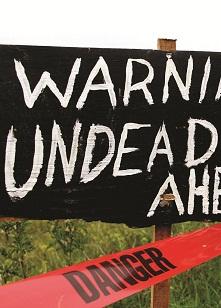

Obstacle racing is the sport in which a competitor, traveling on foot, must overcome various physical challenges (obstacles) in order to progress in the race. Obstacles include, but are not limited to: climbing over walls, carrying heavy objects, traversing bodies of water, crawling under barbed wire, and jumping through fire.
Whew.
In addition to being a great source of pay dirt for cities, obstacle races get a lot of press. Sometimes, they're a good photo opp for feature photographers who love the shots of competitors climbing ropes and slithering through mud pits. Sometimes, they make for longer articles in the sports feature genre that focus on the race, using quotes from participating runners.

Lauren Gambler is customer service supervisor for the creative team that developed the Run for Your Lives race, in which participants not only face obstacles as they race for the finish line, but have to contend with volunteers dressed as zombies en route. (Really. And you thought skateboarding was extreme and edgy?) She has seen this event grow (both in participation numbers, and in numbers of cities hosting the event) since it was first offered in fall of 2011.
Sports Destination Management: Obstacle racing has exploded in popularity over the last two to three years. To what do you attribute that growth?
Lauren Gambler: In the last couple of years, obstacle races have become increasing popular because more people are looking for unique ways to be physically active and get healthy. And since obstacle races are 5K on average, it’s an attainable activity for novice and intermediate runners, and a nice change of pace for marathon runners. It is no longer a path to the finish line, but a whole body workout with twists and turns, ups and downs and other crazy challenges along the way – in our case, that includes the added motivation of being chased by zombies.

LG: Event organizers should make sure a prospective site has several aspects in place that you want illustrated to your participants to help create the environment without having to bring 100 percent of the environment you envision. For example, our first event site in Maryland appeared to be straight out of a 1980s horror movie with old cabins painted red and a giant barn, so the obstacles were the main elements we needed to build to create the perfect scene. And of course, there needed to be natural terrain of hills and water to really make the event work. Beyond that, standard checklists include a good infrastructure, nearby lodging and/or campgrounds, proximity to major cities and parking.
SDM: What have you learned by organizing this race, and what would you tell others who are planning their own?

SDM: Some obstacle races are setting up 'junior' courses for children with smaller distances and less formidable obstacles. Do you think this will become a trend?
LG: Safety is a huge concern for race directors, so while there may be an increase in children wanting to participate along with their parents on a scaled-down obstacle race course, I’m not sure this trend will truly catch up if you look at it from a safety/liability perspective. But kids are certainly the best spectators and once they hit 14, they can participate in our event.
SDM: Do you see more men or more women in the Run for Your Lives? Any age demographics you've noticed?
LG: It’s been about 50/50 men vs. women across the board. The average age of our participants is in the 25-35 age range. However, we have participants as young as 14 participate up to over 70.

